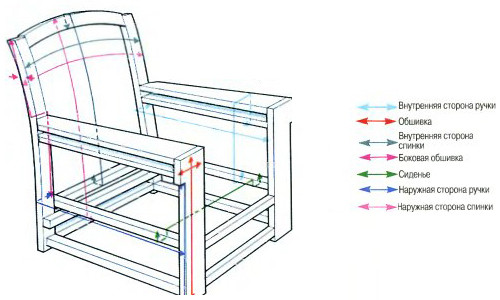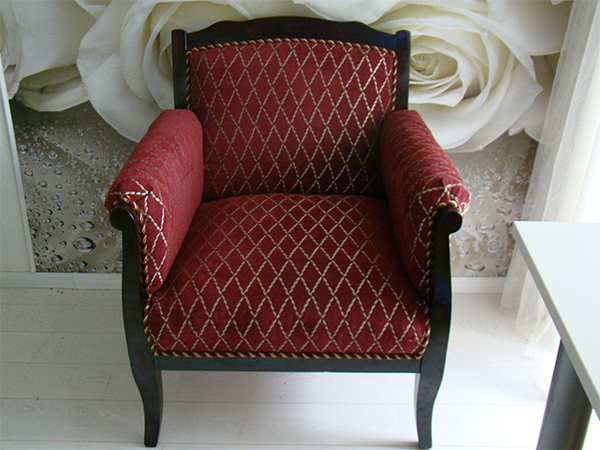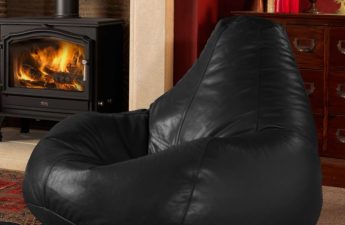Any chair starts to deteriorate over time,the upholstery is torn, and if there is a cross with wheels, then they may need to be replaced. Do-it-yourself chair repair is not so difficult, it can be considered using the example of a small chair on wheels that requires re-upholstery, replacement of padding. Scheme of the chair structure.
Scheme of the chair structure.
How to repair an old chair?
Before repairing the chair with your own hands, you must immediately prepare all the materials and tools that will be needed to perform such work. The list is as follows:
- Cloth for covering the chair (it can be velor, suede, natural or artificial leather and other types of furniture upholstery);
- a piece of natural or artificial leather for the armrests and for the cross;
- foam rubber for replacing the packing (for the seat you can take foam polyethylene). The thickness of the packing is usually 20-40 mm;
- for the lining you can use sintepon;
- threads and needles;
- scissors;
- buttons that can be covered with a cloth;
- Furniture stapler;
- drill;
- Spare wheel spigot, if replacement is required.
Before you repair the chair yourselfby hand, it is necessary to disassemble it. Furniture is usually made on the basis of metal frames, fastened with bolts, so there should be no difficulties. It is only necessary to remember how exactly and in what places individual elements of the structure were attached. You will have to remove the back and disassemble it, remove the seat, remove the crosspiece with wheels. Return to the table of contents</a>
Seat Folding
 Figure 1.In order to transform the chair, it is enough to re-upholster its seat and back. In the seat, not only the fabric should be replaced, but also the padding. The choice of material in this case depends on the chair model. If you need a soft seat, you can take foam rubber, but in some cases a piece of foamed polyethylene of the required thickness is also perfect (you need to focus on the thickness of the old padding). The material is carefully cut out, and then glued to the base. It is best to cut the padding so that it goes slightly beyond the edges, from the wrong side the material is attached with a furniture stapler. The next step is to pattern a piece of fabric for the upholstery. It is made in the form of a cover, all seams are best done with a turnout, if the fabric is thick enough, and its edges do not require additional processing. This option is perfect for leather, suede, some thick woolen fabrics. For the rest, a regular cover is sewn, which is then turned inside out and pulled over the seat. The fabric must be straightened, the remaining part must be sewn up. If a cushion is used for the chair, then a rather original but convenient fastening system can be provided for it. A Velcro tape is sewn onto the seat during the sewing of the cover. The second part of the Velcro is attached to the cushion cover. Return to the table of contents</a>
Figure 1.In order to transform the chair, it is enough to re-upholster its seat and back. In the seat, not only the fabric should be replaced, but also the padding. The choice of material in this case depends on the chair model. If you need a soft seat, you can take foam rubber, but in some cases a piece of foamed polyethylene of the required thickness is also perfect (you need to focus on the thickness of the old padding). The material is carefully cut out, and then glued to the base. It is best to cut the padding so that it goes slightly beyond the edges, from the wrong side the material is attached with a furniture stapler. The next step is to pattern a piece of fabric for the upholstery. It is made in the form of a cover, all seams are best done with a turnout, if the fabric is thick enough, and its edges do not require additional processing. This option is perfect for leather, suede, some thick woolen fabrics. For the rest, a regular cover is sewn, which is then turned inside out and pulled over the seat. The fabric must be straightened, the remaining part must be sewn up. If a cushion is used for the chair, then a rather original but convenient fastening system can be provided for it. A Velcro tape is sewn onto the seat during the sewing of the cover. The second part of the Velcro is attached to the cushion cover. Return to the table of contents</a>
Works with back
To make it convenient to work with the back, it must bedisassemble. Small chairs today are often made on a metal frame, from which the back is removed in the same way as the seat. The back can be one-piece or made of two parts. Repair in the second case is simpler. There is no need to sew anything, only the padding will be replaced, reupholstered with new fabric and buttons added. As a result, your favorite chair will literally be transformed before your eyes. An example of restoration work is shown in Fig. 1. Figure 2.It is advisable to select the upholstery fabric in the same tones as the other furniture in the house. What is the best place to start the restoration work? First, you need to prepare the wooden base of the back for re-upholstery. Using a ruler and a simple pencil, mark the back in the form of diamonds. The intersection points will be the place where the buttons are attached. Holes are drilled at these points. Next, you need to glue a piece of foam rubber to the back. If necessary, a double layer of foam rubber is made at the bottom of the back. Carefully make holes in the foam rubber for the future buttons. After the main part of the work is finished, you need to start upholstering both parts of the back (front and back). The fabric is pre-cut, the scraps are left, as they will be used to cover the buttons. To stretch the fabric, use , but you can fix the fabric with a furniture stapler. During the upholstery, you should make sure that there are no folds left. On the front part, the fabric is additionally stretched using decorative buttons. You can use different fabrics to cover the chair, but they must be durable. In addition, the fabric must be easy to clean; genuine or artificial leather, velour are good for this job. It is best to choose the same color as the other chairs and sofas in the room, so that the upholstery matches them or is made in the same tone. Another example of a restored chair can be seen in Fig. 2. Return to Contents</a>
Figure 2.It is advisable to select the upholstery fabric in the same tones as the other furniture in the house. What is the best place to start the restoration work? First, you need to prepare the wooden base of the back for re-upholstery. Using a ruler and a simple pencil, mark the back in the form of diamonds. The intersection points will be the place where the buttons are attached. Holes are drilled at these points. Next, you need to glue a piece of foam rubber to the back. If necessary, a double layer of foam rubber is made at the bottom of the back. Carefully make holes in the foam rubber for the future buttons. After the main part of the work is finished, you need to start upholstering both parts of the back (front and back). The fabric is pre-cut, the scraps are left, as they will be used to cover the buttons. To stretch the fabric, use , but you can fix the fabric with a furniture stapler. During the upholstery, you should make sure that there are no folds left. On the front part, the fabric is additionally stretched using decorative buttons. You can use different fabrics to cover the chair, but they must be durable. In addition, the fabric must be easy to clean; genuine or artificial leather, velour are good for this job. It is best to choose the same color as the other chairs and sofas in the room, so that the upholstery matches them or is made in the same tone. Another example of a restored chair can be seen in Fig. 2. Return to Contents</a>
Cross repair
If the chair cross is broken orhas acquired a completely unsightly appearance, then it can be replaced. This will cost much less than replacing individual elements that will need to be purchased somewhere. To keep costs to a minimum, you can buy a plastic cross (these are usually used for office chairs). But since its appearance is not quite suitable for a home chair, the plastic can be covered with natural or beautiful artificial leather. This is not so difficult to do, it is enough to cut a piece of leather so that it tightly covers the parts of the cross to the wheels and the vertical part. They must be sewn with a special waxed thread, its color can be matched to the color of the leather or use a contrasting one. The armrests can be finished in a similar way so that the chair looks beautiful and harmonious. The leather must be reinforced with decorative nails yourself. If you have experience, the surface of the leather can be decorated with special paint. After all the individual elements for the chair are ready, you can begin assembly. For the back, buttons are made from fabric, they are attached with a stapler or strong nylon thread on the back side. Next, the back of the chair is reinforced. The cross is screwed into place. This completes the DIY chair repair. If the upholstery on your favorite chair is torn or the armrests have become unsightly and badly scratched, it is not at all necessary to throw it away or cover it with a cover. You can easily repair furniture with your own hands, completely changing the appearance or simply replacing the upholstery. This work is not difficult, you just need to clearly define what needs to be done and prepare the materials.


